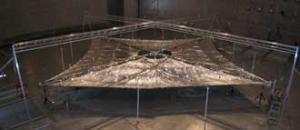Interstellar propulsion studies were upstaged in 2004 as we followed planetary exploration: the progress of the Spirit and Opportunity Mars rovers, the Cassini Saturn orbiter and the upcoming Huygens descent onto Titan. But the year was not without significant interstellar news, even though it received little media attention.
 In separate tests in Ohio and Virginia, two NASA contractors successfully tested solar sail deployments on sails of their own design. In July, L’Garde (Tustin CA) deployed a solar sail nearly 33 feet in length along one side; a separate design created by Able Engineering of Goleta was tested in April and May. The engineering and analysis that went into these tests will help us get sails into space for testing even as we await the launch of the private Cosmos 1 sail sponsored by the Planetary Society.
In separate tests in Ohio and Virginia, two NASA contractors successfully tested solar sail deployments on sails of their own design. In July, L’Garde (Tustin CA) deployed a solar sail nearly 33 feet in length along one side; a separate design created by Able Engineering of Goleta was tested in April and May. The engineering and analysis that went into these tests will help us get sails into space for testing even as we await the launch of the private Cosmos 1 sail sponsored by the Planetary Society.
Image: A four-quadrant solar sail system sits fully deployed in a 100-foot-diameter vacuum chamber at NASA’s Glenn Research Center Plum Brook Station in Sandusky, Ohio. NASA’s solar sail propulsion team at the Marshall Space Flight Center in Huntsville, Ala., and its industry partner, L’Garde, Inc., of Tustin, Calif., successfully deployed the solar sail system during testing at the Plum Brook facility in early July 2004. Credit: NASA/L’Garde, Inc.
Solar sails intrigue propulsion theorists because they require no onboard fuel. Working only with photons produced by the sun and using enormous sails, they should be able to perform maneuvers, like hovering at a point in space, that would quickly exhaust conventional propulsion systems. For interstellar purposes, a close pass by the Sun (the so-called ‘Sun-diver’ maneuver) has been suggested as a way to build up velocity before deploying the sail, using proximity to the Sun to get the maximum impact from the photon stream. Gregory Matloff has studied ‘close pass’ maneuvers that could launch an Alpha Centauri mission with a flight time of roughly 1,000 years.
But the problems sails pose are huge, especially in terms of deployment. Even now, before we have developed the much thinner films that will power future space sails, the material they are made of is up to 100 times thinner than a sheet of writing paper. How do you get such a sail deployed without tearing its evanescent fabric? To find out, L’Garde’s deployment was conducted in a 100-ft. vacuum chamber at NASA’s Glenn Research Center Plum Brook Station in Sandusky, OH, where temperatures were kept low to simulate the environment of space. The use of inflatable booms that become stiff once deployed proved workable; these support the reflective sail.
Able Engineering’s work was done at Langley Research Center in Hampton, VA, using a graphite boom that is extended by remote control. Tests were conducted in a 50-foot vacuum chamber, with the April deployment followed by five weeks of study to examine the sail’s shape and system dynamics. All this in preparation for a planned 2005 laboratory deployment of a 65-foot sail that will draw on the results of both sets of tests.
When I talked to Moktar Salama last year about his work with solar sails, the JPL scientist noted that square sails, like the two tested above, are what is known as three-axis stabilized sails; they can be controlled along all three axes. Salama believes square sails are workable for sails up to 100 meters in size, but as they become larger, the external structure needed to maintain them becomes more and more of a burden. Spinning sails, on the other hand, can use spin for deployment and are maneuverable without the mass of booms and struts.
When I asked Salama about future sails for deep space missions, he saw the spinning sail as essential. “With a three axis stabilized sail on a smaller scale, the initial problems for testing are easier to solve. Three axis sails will probably be tested first, and I’m pretty sure they will be flown first. We can do quite a few things with a smaller sail before we will need a bigger sail. But longer-term, we move into circular spinning sails. Especially for missions to the outer edges of the Solar System.” And yes, Salama confirmed that spinning sails could be adapted for laser-beam propulsion in the Robert Forward mode.
All told, 2004 was a significant year for the propulsion system that may have the best chance at powering our first interstellar precursor missions. The next date to watch is March 1, when Cosmos 1 is scheduled to be launched by a Volna rocket from a submerged submarine in the Barents Sea. If successful, this privately funded mission will accomplish the first controlled solar sail flight.

